
| Version | Summary | Created by | Modification | Content Size | Created at | Operation |
|---|---|---|---|---|---|---|
| 1 | Michał Łach | -- | 3032 | 2024-03-04 10:00:06 | | | |
| 2 | Peter Tang | Meta information modification | 3032 | 2024-03-04 10:07:57 | | |
Video Upload Options
Phase change materials (PCM) were known already in the 1970s (similarly to geopolymers), but their development is observed today. This is related to the possibility of obtaining a stable phase as well as the possibility of optimization of construction materials concerning the construction needs. These materials can change their physical state depending on the ambient temperature. The most common method is liquid-solid conversion. In the area of application of phase change materials in the construction industry, examples of such materials include organic materials (paraffin, fatty acids), inorganic materials, and eutectics.
1. Introduction
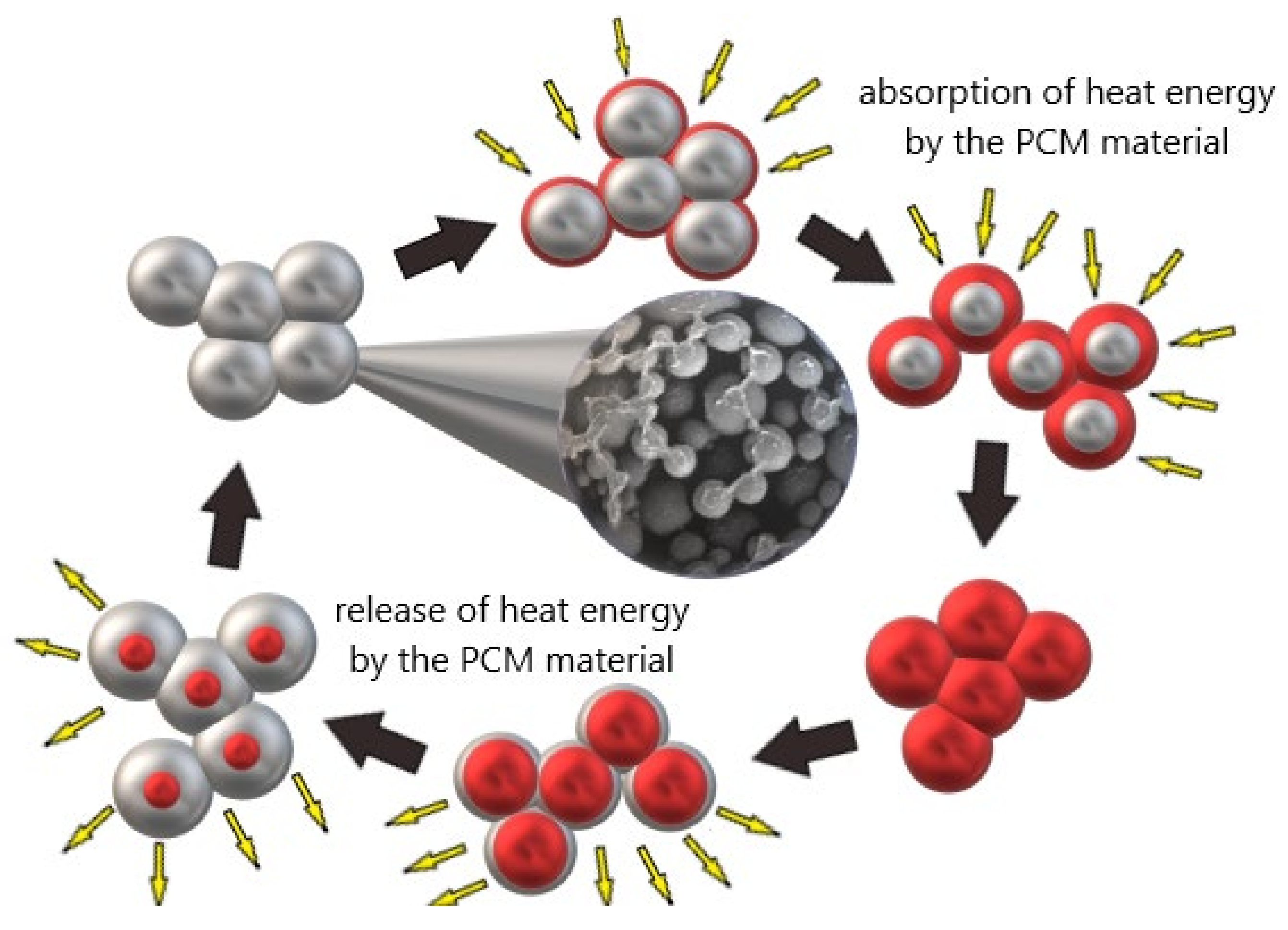
2. Characteristics and Classification of Phase Change Materials
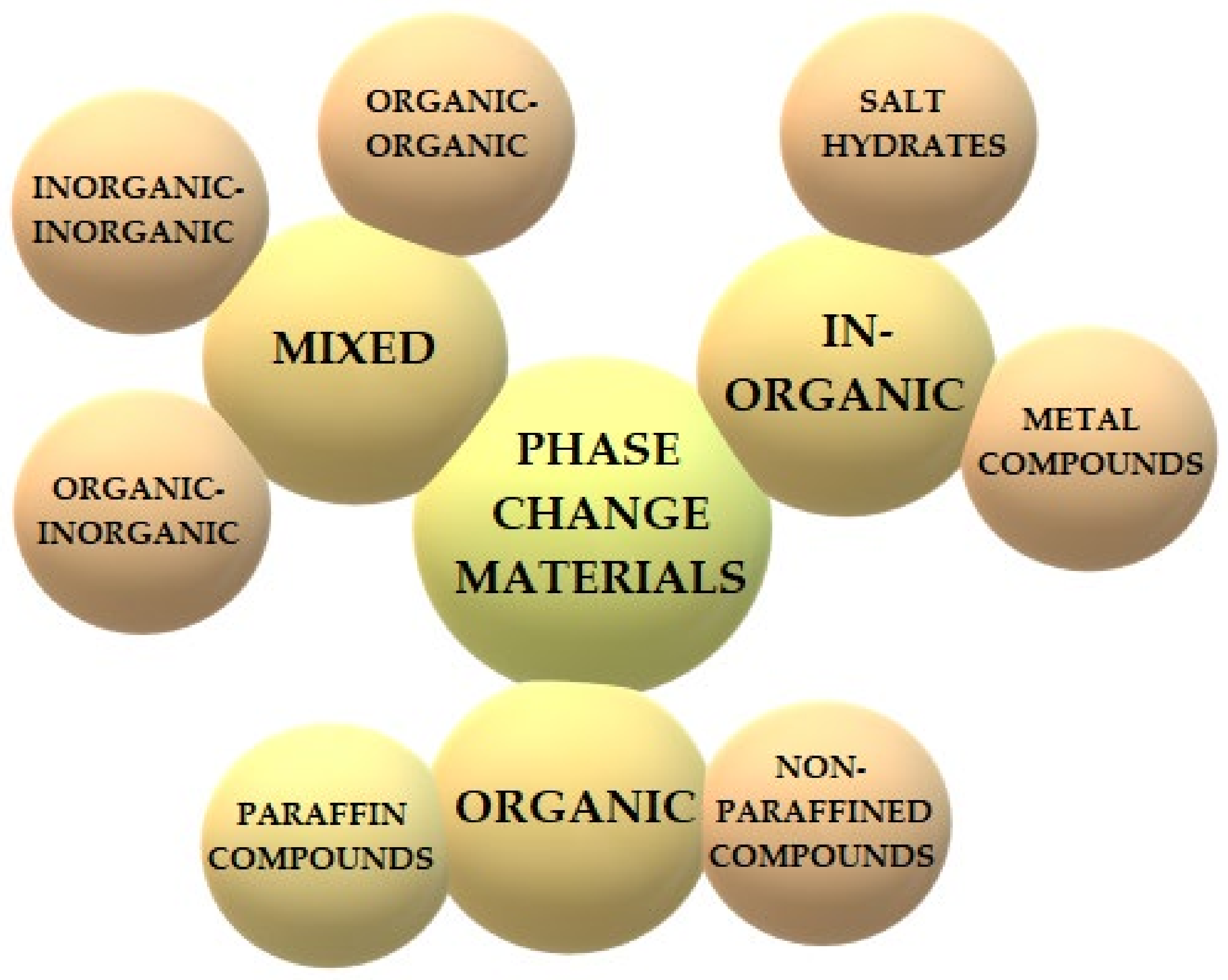
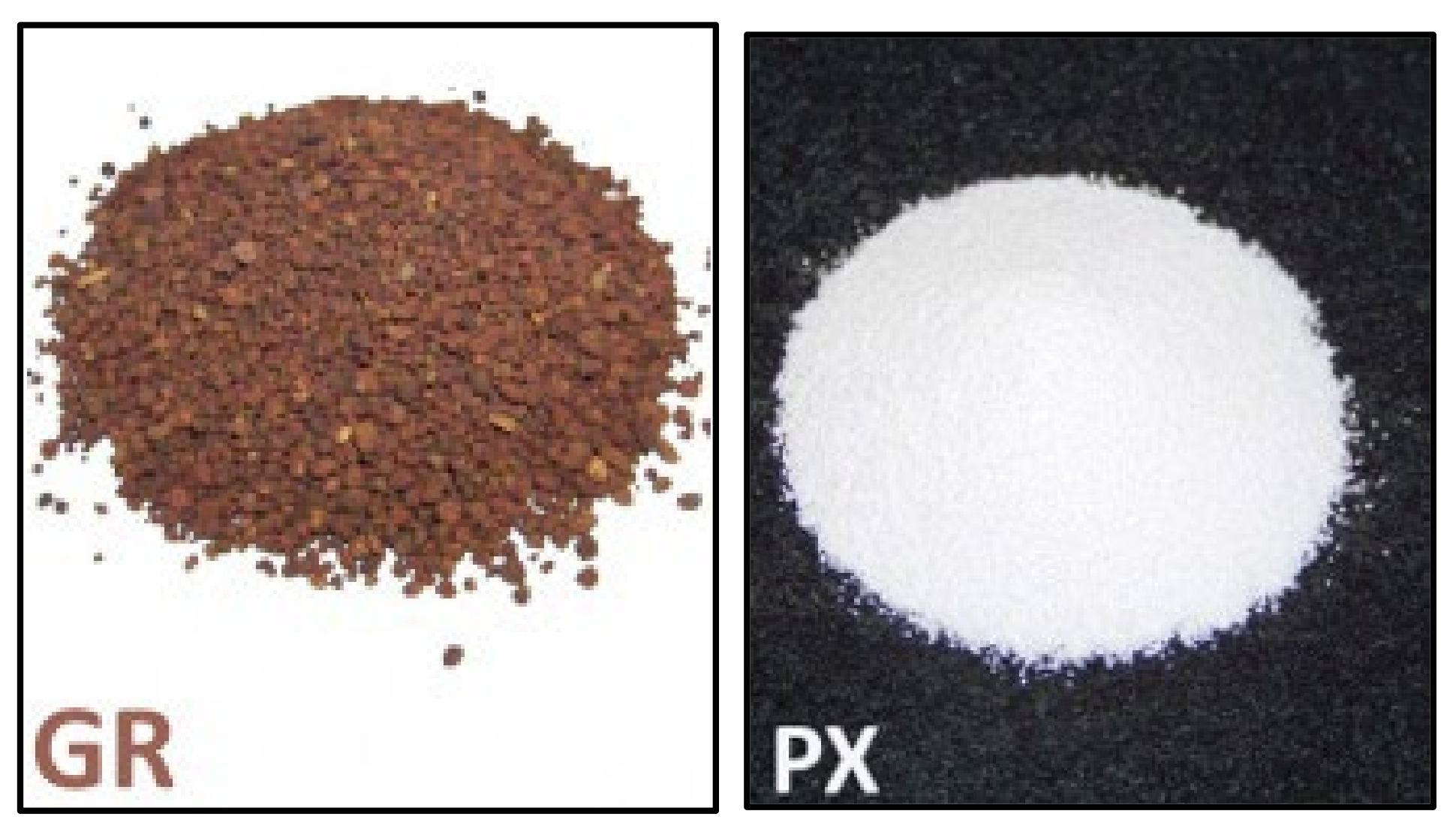
3. Methods of Incorporation of PCM into Geopolymers and Concrete
-
Microencapsulation (PCMs are enclosed in spherical shells),
-
Shape stabilized PCMs (Molten PCM is directly absorbed into powdered porous structure like graphite powder, silica fume, etc. having higher thermal conductivity),
-
Porous aggregate inclusions (Molten PCM is absorbed or impregnated into porous light weight aggregates having large surface area and aggregate size such as expanded perlite, expanded clay, pumice, etc.),
-
Macroencapsulation (PCMs are incorporated into building components such as roofs or walls).
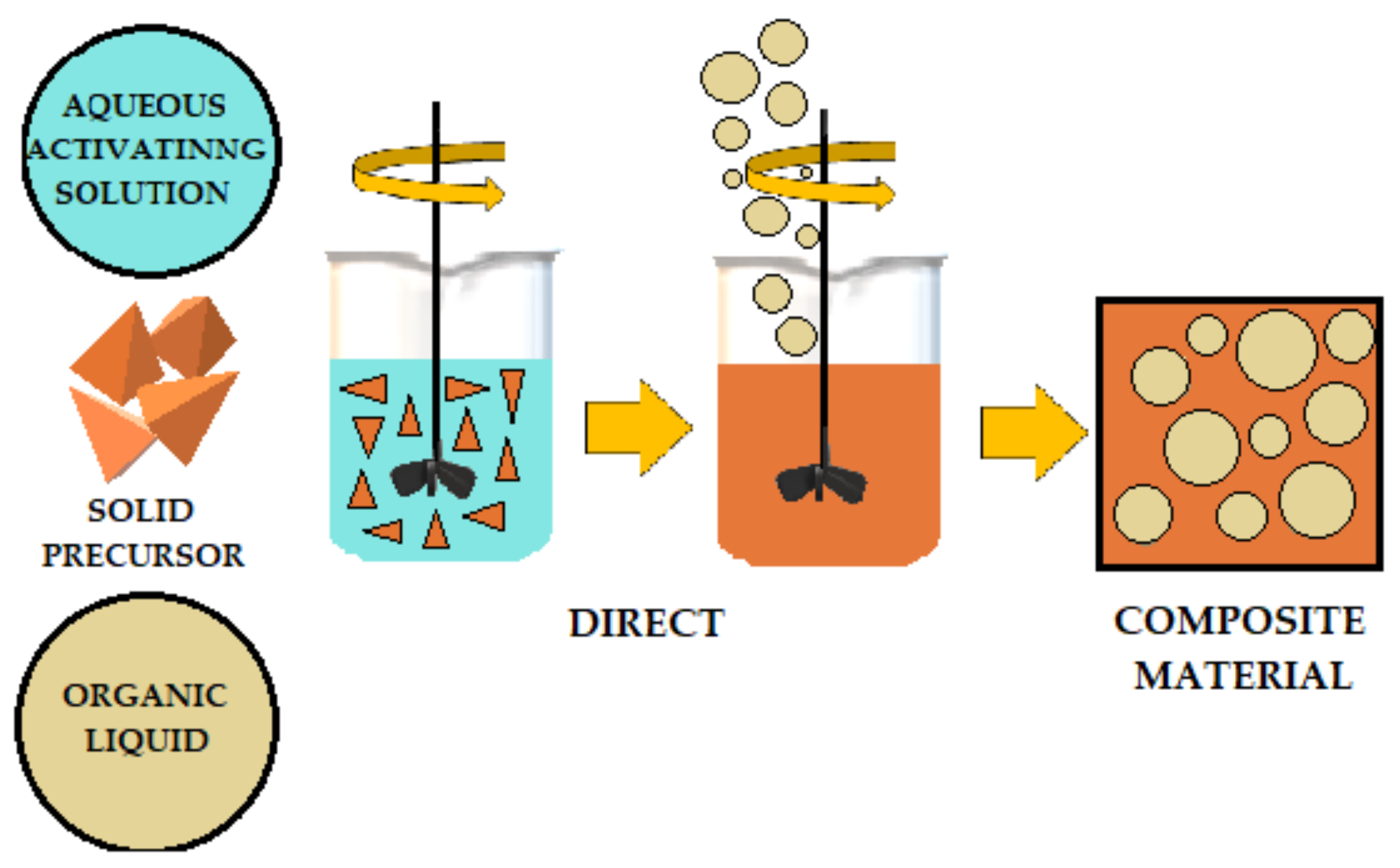
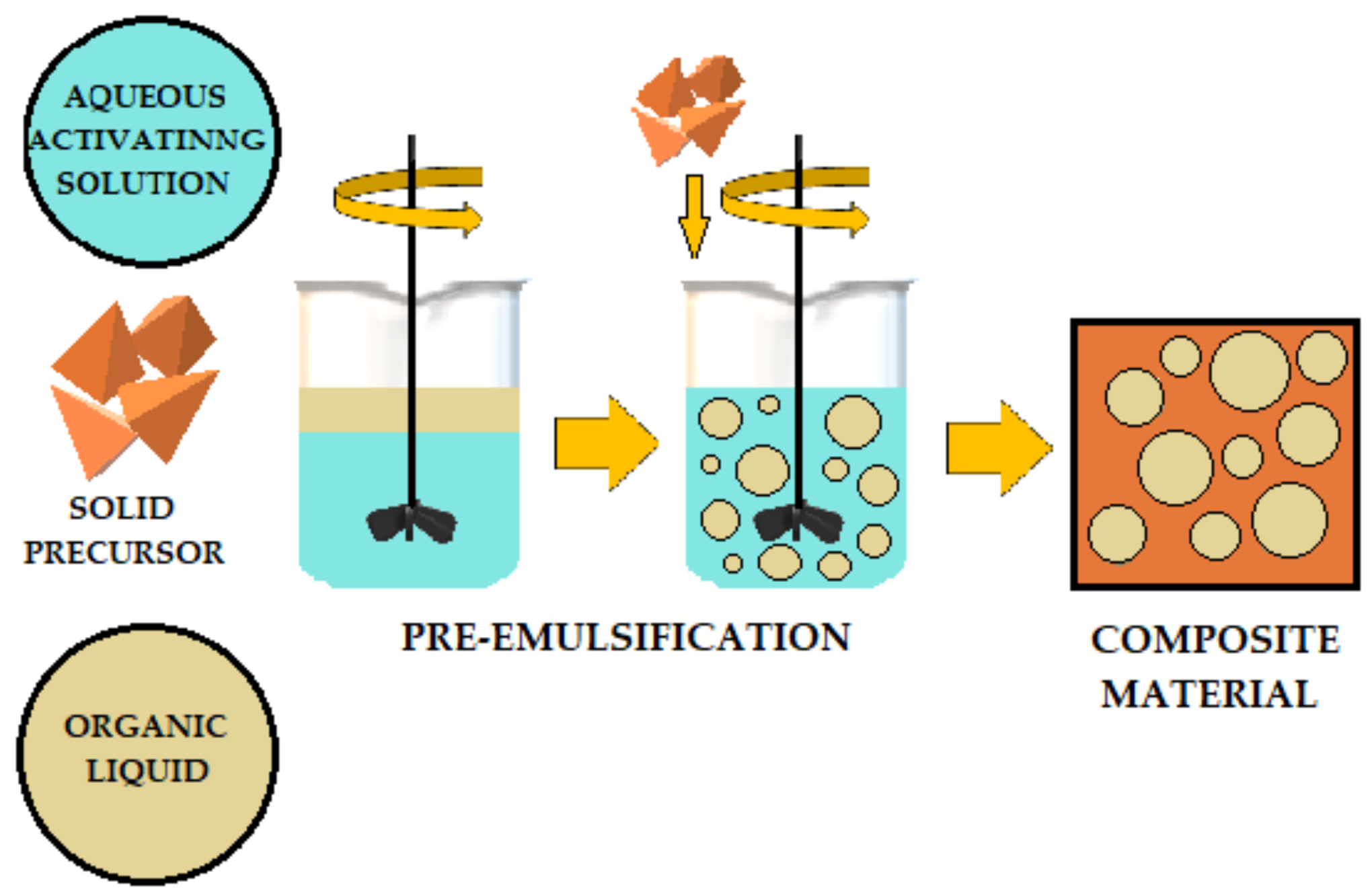
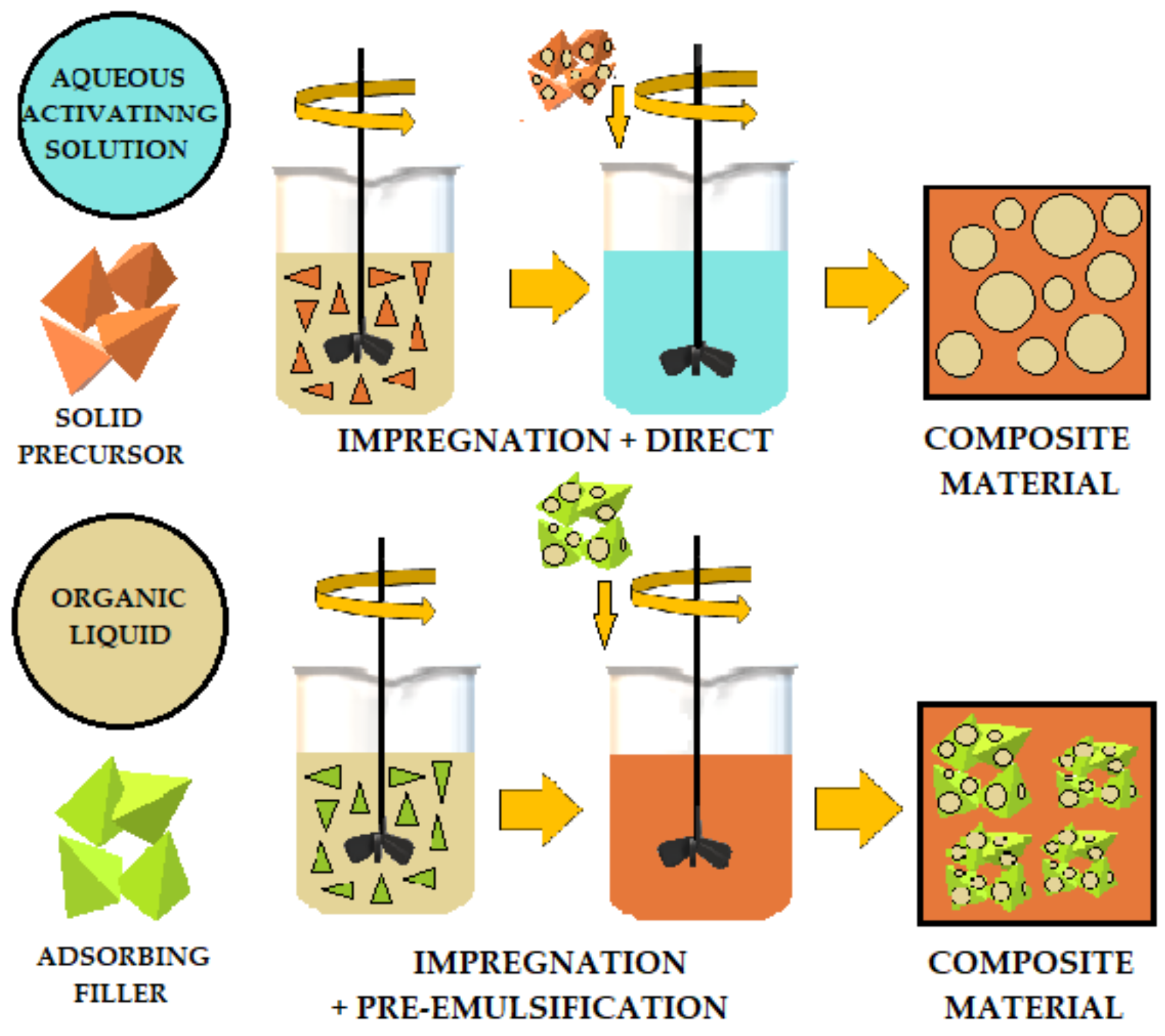
|
Advantages |
Disadvantages |
|
|---|---|---|
|
Direct method |
|
|
|
Preemulsification |
|
|
|
Impregnation |
|
|
4. PCM in Geopolymers—Effect on Insulation Properties
|
Name of PCM |
Producer |
Core Material of PCM |
Melting Point of PCM [°C] |
Heat Capacity of PCM [kJ/kg] |
Form of Applied Matrix for PCM before Incorporation into Geopolymer |
Application Effect in Material |
References |
|---|---|---|---|---|---|---|---|
|
RT31 |
Rubiterm, Berlin, Germany |
Paraffin |
31 |
165 |
Polyurethane foam, covered with geopolymer paste |
Protection against overheating as a passive cooling system |
[51] |
|
MPCM 28D |
Microtek Laboratories, Inc., Dayton, OH, USA |
Paraffin |
28 |
180–195 |
Polymer shells (microcapsules) |
Damping function, less temperature fluctuation; increase in heat capacity |
[52] |
|
PCM |
Avantis Company La- Boratorium Berhad, Ipoh, Perak, Malaysia |
Paraffin |
No data |
189 |
Expanded graphite + CaCl2/sodium silicate coating (microcapsules) |
Storing thermal energy and releasing it as latent heat |
[53] |
|
PCM |
No data |
Eutectic BaCl2 + KCl + NaCl |
No data |
215 |
ZYP coating or Aremco coating or ZAG coatin + geopolymer shells |
Reduction in latent heat of all samples |
[54] |
|
PCM |
No data |
Paraffin |
25 |
230 |
Commercial synthetic rubber emulsion (Sika Latex), commercial liquid waterproofing membrane (Weber dry-lastick), polyester resin adhesive with hardener and catalyst |
The aggregate covered with PCM material allows for the storage of thermal energy and return it as latent hea |
[19] |
|
PS-DVB/RT27 |
Rubitherm, Berlin, Germany |
Paraffin |
24.9 |
100 |
Polymer shells (microcapsules) |
Reduction in energy consumption for internal temperature stabilisation by 18.5 ± 0.3% |
[55] |
|
Micronal DS-5038X |
Microtek Laboratories, Inc. Dayton, OH, USA |
Paraffin |
24.7 |
110 |
Polymer shells (microcapsules) |
Reduction in energy consumption for internal temperature stabilisation by 20.1 ± 0.7% |
[55] |
|
RT27 |
Rubitherm, Berlin, Germany |
Paraffin |
24.9 |
100 |
Composite made by vacuum mixing hydrophobic expanded perlite (EP) and paraffin in a 1:1 ratio |
Geopolymer foam concrete (GFC) showed little temperature variation and little loss |
[30] |
References
- Allouhi, A.; El Fouih, Y.; Kousksou, T.; Jamil, A.; Zeraouli, Y.; Mourad, Y. Energy consumption and efficiency in buildings: Current status and future trends. J. Clean. Prod. 2015, 109, 118–130.
- Muraleedharan, M.; Nadir, Y. Geopolymer mortar integrated with phase change materials for improvement of thermal efficiency in buildings: A review. Mater. Today Proc. 2020, 44, 878–885.
- Singh, N.B.; Middendorf, B. Geopolymers as an alternative to Portland cement: An overview. Constr. Build. Mater. 2020, 237, 117455.
- Davidovits, J. Geopolymer Chemistry and Applications, 4th ed.; Institut Géopolymère: Saint-Quentin, France, 2015.
- Cong, P.; Yaqian Cheng, Y. Advances in geopolymer materials: A comprehensive review. J. Traffic Transp. Eng. Engl. Ed. 2021, 8, 283–314.
- El Hafid, K.; Hajjaji, M.; Hafid, H.E. Influence of NaOH concentration on microstructure and properties of cured alkali-activated calcined clay. J. Build. Eng. 2017, 11, 158–165.
- Aiken, T.A.; Kwasny, J.; Sha, W.; Soutsos, M.N. Effect of slag content and activator dosage on the resistance of fly ash geopolymer binders to sulfuric acid attack. Cem. Concr. Res. 2018, 111, 23–40.
- Aliques-Granero, J.; Tognonvi, M.T.; Tagnit-Hamou, A. Durability study of AAMs: Sulfate attack resistance. Constr. Build. Mater. 2019, 229, 117100.
- Lahoti, M.K.; Tan, K.H.; Yang, E.H. A critical review of geopolymer properties for structural fire-resistance applications. Constr. Build. Mater. 2019, 221, 514–526.
- Shill, S.K.; Al-Deen, S.; Ashraf, M.; Hutchison, W. Resistance of fly ash based geopolymer mortar to both chemicals and high thermal cycles simultaneously. Constr. Build. Mater. 2020, 239, 117886.
- Ciemnicka, J.; Prałat, K.; Koper, A.; Makomaski, G.; Majewski, Ł.; Wójcicka, K.; Buczkowska, K.E. Changes in the Strength Properties and Phase Transition of Gypsum Modified with Microspheres, Aerogel and HEMC Polymer. Materials 2021, 14, 3486.
- Vafaei, M.; Allahverdi, A.; Dong, P.; Bassim, N. Acid attack on geo-polymer cement mortar based on waste-glass powder and calcium aluminate cement at mild concentration. Constr. Build. Mater. 2018, 193, 363–372.
- Gado, R.A.; Hebda, M.; Lach, M.; Mikula, J. Alkali activation of waste clay bricks: Influence of the silica modulus, SiO2/Na2O, H2O/Na2O molar ratio, and liquid/solid ratio. Materials 2020, 13, 383.
- Łach, M. Geopolymer foams—Will they ever become a viable alternative to popular insulation materials?—A critical opinion. Materials 2021, 14, 3568.
- Łach, M.; Korniejenko, K.; Mikuła, J. Thermal insulation and thermally resistant materials made of geopolymer foams. Proc. Eng. 2016, 151, 410–416.
- Korniejenko, K.; Łach, M. Geopolymers reinforced by short and long fibres–innovative materials for additive manufacturing. Curr. Opin. Chem. Eng. 2020, 28, 167–172.
- Łach, M.; Hebdowska-Krupa, M.; Stefańska, A.; Mikuła, J.; Hebda, M. Characterisation of post-production raw material from the Raciszyn II deposit as a material suitable for the production of alkaline-activated materials. J. Therm. Anal. Calorim. 2019, 138, 4551–4559.
- Korniejenko, K.; Łach, M.; Chou, S.-Y.; Gadek, S.; Mikuła, J. Mechanical properties of short fiber-reinforced geopolymers made by casted and 3D printing methods: A comparative study. Materials 2020, 13, 579.
- Kastiukas, G.; Zhou, X.; Castro-Gomes, J. Development and optimisation of phase change material-impregnated lightweight aggregates for geopolymer composites made from aluminosilicate rich mud and milled glass powder. Constr. Build. Mater. 2016, 110, 201–210.
- Parameshwaran, R.; Harikrishnan, S.; Kalaiselvam, S. Energy efficient PCM-based variable air volume air conditioning system for modern buildings. Energy Build. 2010, 42, 1353–1360.
- Lone, M.I.; Jilte, R. A review on phase change materials for different applications. Mater. Today Proc. 2021, 46, 10980–10986.
- Dhaidan, N.S.; Khodadadi, J.M. Melting and convection of phase change materials in different shape containers: A review. Renew. Sustain. Energy Rev. 2015, 43, 449–477.
- Ma, T.; Yang, H.; Zang, Y.; Lu, L.; Wang, X. Using chase change materials in photovoltaic systems for thermal regulation and electrical efficiency improvement: A review and outlook. Renew. Sustain. Energy Rev. 2015, 43, 1273–1284.
- Zhou, Z.; Zang, Z.; Zuo, J.; Huang, K.; Zhang, L. Phase change materials for solar thermal energy storage in residential buildings in cold climate. Renew. Sustain. Energy Rev. 2015, 48, 692–703.
- Seddegh, S.; Wang, X.; Henderson, A.D.; Xing, Z. Solar domestic hot water systems using latent heat energy storage medium: A review. Renew. Sustain. Energy Rev. 2015, 49, 517–533.
- D’Alessandro, A.; Pisello, A.L.; Fabiani, C.; Ubertini, F.; Cabeza, L.F.; Cotana, F. Multi- functional smart concretes with novel phase change materials: Mechanical and thermo-energy investigation. Appl. Energy 2018, 212, 1448–1461.
- Ling, T.C.; Poon, C.S. Use of phase change materials for thermal energy storage in concrete: An overview. Constr. Build. Mater. 2013, 46, 55–62.
- Rao, V.V.; Parameshwaran, R.; Ram, V.V. PCM-mortar based construction materials for energy efficient buildings: A review on research trends. Energy Build. 2018, 158, 95–122.
- Cao, V.D.; Pilehvar, S.; Salas-Bringas, C.; Szczotok, A.M.; Bui, T.Q.; Carmona, M.; Rodriguez, J.F.; Kjøniksen, A.L. Thermal analysis of geopolymer concrete walls containing microencapsulated phase change materials for building applications. Sol. Energy 2019, 178, 295–307.
- Ramakrishnan, S.; Pasupathy, K.; Sanjayan, J. Synthesis and properties of thermally enhanced aerated geopolymer concrete using form-stable phase change composite. J. Build. Eng. 2021, 40, 102756.
- Sukontasukkul, P.; Nontiyutsirikul, N.; Songpiriyakij, S.; Sakai, S.; Chindaprasirt, P. Use of phase change material to improve thermal properties of lightweight geopolymer panel. Mater. Struct. 2016, 49, 4637–4645.
- Gasca-Tirado, J.R.; Manzano-Ramírez, A.; Velázquez-Castillo, R.R.; Gómez-Luna, B.E.; Nava-Mendoza, R.F.; López-Romero, J.M.; Apátiga-Castro, L.M.; Rivera-Muñoz, E.M. Porous geopolymer as a possible template for a phase change material. Mater. Chem. Phys. 2019, 236, 121785.
- Mehling, H.; Cabeza, L.F. Heat and Cold Storage with PCM. An up to Date Introduction into Basics and Applications; Springer: Berlin/Heidelberg, Germany, 2008.
- Zalba, B.; Martyn, J.M.; Cabeza, L.F.; Mehling, H. Review on thermal energy storage with phase change: Materials, heat transfer analysis and applications. Appl. Therm. Eng. 2003, 23, 251–283.
- Zhang, Y.; Zhou, G.; Lin, K.; Zhang, Q.; Di, H. Application of latent heat thermal energy storage in buildings: State-of-the-art and outlook. Build. Environ. 2007, 42, 2197–2209.
- Pasupathy, A.; Velraj, R. Effect of double layer phase change material in building roof for year round thermal management. Energy Build. 2008, 40, 193–203.
- Tyagi, V.V.; Buddhi, D. PCM thermal storage in buildings: A state of art. Renew. Sustain. Energy Rev. 2007, 11, 1146–1166.
- Jaworski, M. Materiały zmiennofazowe (PCM) do zastosowań w budownictwie. Pol. Energetyka Słoneczna 2008, 1–4, 57–60.
- Navarro Farré, L.; Solé, A.; Martín, M.; Barreneche Güerisoli, C.; Olivieri, L.; Tenorio, J.A.; Cabeza, J.F. Benchmarking of useful phase change materials for a building application. Energy Build. 2018, 182, 45–50.
- Sharma, A.; Tyagi, V.V.; Chen, C.R.; Buddhi, D. Review on thermal energy storage with phase changematerials and applications. Renew. Sustain. Energy Rev. 2009, 13, 318–345.
- Cabeza, L.F.; Castell, A.; Barreneche, C.; De Gracia, A.; Fernández, A.I. Materials used as PCM in thermal energy storage in buildings: A review. Renew. Sustain. Energy 2011, 15, 1675–1695.
- Sodha, M.S.; Sawhney, R.L.; Buddhi, D. Use of evaporatively cooled underground water storage for convective cooling of buildings: An analytical study. Energy Convers. Manag. 1994, 35, 683–688.
- Abhat, A. Low temperature latent heat thermal energy storage: Heat storage materials. Sol. Energy 1983, 30, 313–332.
- Magendran, S.S.; Khan, F.S.A.; Mubarak, N.M.; Vaka, M.; Walvekar, R.; Khalid, M.; Abdullah, M.C.; Nizamuddin, S.; Karri, R.R. Synthesis of organic phase change materials (PCM) for energy storage applications: A review. Nano Struct. Nano Objects 2019, 20, 100399.
- Melcer, A.; Klugmann-Radziemska, E.; Lewandowski, W. Phase change materials on the market-properties and applications. Przemysł Chemiczny 2012, 9, 1733–1742.
- PX & GR BOUND PCM. Available online: https://www.rubitherm.eu/en/index.php/productcategory/materialkombinationen-gebundene-pcm-gr-px (accessed on 29 August 2021).
- Reeb, C.; Pierlot, C.; Davy, C.; Lambertin, D. Incorporation of organic liquids into geopolymer materials- A review of processing, properties and applications. Ceram. Int. 2020, 47, 7369–7385.
- Pilehvar, S.; Cao, V.D.; Szczotok, A.M.; Carmona, M.; Valentini, L.; Lanzón, M.; Pamies, R.; Kjøniksen, A. Physical and mechanical properties of fly ash and slag geopolymer concrete containing different types of micro-encapsulated phase change materials. Constr. Build. Mater. 2018, 173, 28–39.
- Wang, Z.; Su, H.; Zhao, S.; Zhao, N. Influence of phase change material on mechanical and thermal properties of clay geopolymer mortar. Constr. Build. Mater. 2016, 120, 329–334.
- Cao, V.D.; Pilehvar, S.; Salas-Bringas, C.; Szczotok, A.M.; Valentini, L.; Carmona, M.; Rodriguez, J.F.; Kjøniksen, A. L Influence of microcapsule size and shell polarity on thermal and mechanical properties of thermoregulating geopolymer concrete for passive buildingapplications. Energy Convers. Manag. 2018, 164, 198–209.
- Hassan, A.; Rashid, Y.; Mourad, A.I.; Ismail, N.; Laghari, M.S. Thermal and Structural Characterization of Geopolymer-Coated Polyurethane Foam—Phase Change Material Capsules/Geopolymer Concrete Composites. Materials 2019, 12, 796.
- Shadnia, R.; Zhang, L.; Li, P. Experimental study of geopolymer mortar with incorporated PCM. Constr. Build. Mater. 2015, 84, 95–102.
- Afolabi, L.O.; Ariff, Z.M.; Megat-Yusoff, P.S.M.; Al-Kayiem, H.H.; Arogundade, A.I.; Afolabi-Owolabi, O.T. Red-mud geopolymer composite encapsulated phase change material for thermal comfort in built-sector. Sol. Energy 2019, 181, 464–474.
- Jacob, R.; Raud, R.; Trout, N.; Bell, S.; Clarke, S.; Will, H.; Saman, W.; Bruno, F. Effect of inner coatings on the stability of chloride-based phase change materials encapsulated in geopolymer. Sol. Energy Mater. Sol. Cells. 2018, 174, 271–276.
- Micronal DS 5038 X. Available online: https://cdn2.hubspot.net/hubfs/4153344/Microtek%20Laboratories%20December2017/PDF/MPDS3300-0044%20Rev%201.pdf?t=1516975227818 (accessed on 29 August 2021).




